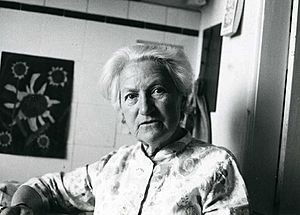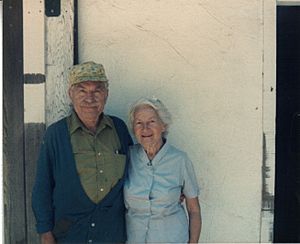Lucienne Bloch facts for kids
Quick facts for kids
Lucienne Bloch
|
|
|---|---|
 |
|
| Born |
Lucienne Bloch
January 5, 1909 Geneva, Switzerland
|
| Died | March 13, 1999 (aged 90) Gualala, California, United States
|
| Nationality | American |
| Education | École nationale supérieure des Beaux-Arts |
| Known for | Sculpture, painting, photography |
| Spouse(s) | Stephen Pope Dimitroff |
| Patron(s) | WPA, FAP |
Lucienne Bloch (born January 5, 1909 – died March 13, 1999) was an American artist. She was born in Switzerland. Lucienne Bloch was best known for her large wall paintings called murals. She was also famous for working with the Mexican artist Diego Rivera. She took the only photos of Rivera's mural Man at the Crossroads. This mural was painted in 1933 and later destroyed.
Contents
Lucienne Bloch's Artistic Journey
Early Life and Art School
Lucienne Bloch was born in Geneva, Switzerland, in 1909. She was the youngest child of Ernest Bloch, a composer and photographer. In 1917, her family moved to America.
Lucienne was a very talented artist. At just 14, she went to the École nationale supérieure des Beaux-Arts in Paris. There, she learned from famous artists like sculptor Antoine Bourdelle and painter Andre Lhote. Her friend Beniamino Bufano also helped her with her sculpture work.
Working with Famous Artists
In 1929, Lucienne Bloch started designing glass sculptures. She worked for the Royal Leerdam Crystal Glass Factory in the Netherlands. Frank Lloyd Wright, a very famous architect, saw her glass art. He invited her to teach at his architecture school, Taliesin East.
Then, in 1931, Bloch met Diego Rivera, a well-known muralist. She became his apprentice, helping him paint large frescoes. These murals were in New York (1931, 1933) and Detroit (1932). She also became very close friends with Rivera's wife, Frida Kahlo. They were companions and shared many secrets. Lucienne went with Kahlo to Mexico when Kahlo's mother was sick. She was also with Kahlo in Detroit during a difficult time.
Lucienne Bloch was also a great photographer. She took many pictures of Rivera and Kahlo. These photos are now used in books about their lives. She took the only existing photos of Rivera's mural, Man at the Crossroads. This mural was painted in Rockefeller Center in New York City. It was later destroyed because it was controversial. She created five collections of photos of Rivera and Kahlo. These included pictures of Kahlo's paintings as they were being made. She also photographed the artists in New York City, Detroit, and Mexico.
Creating Murals Across America
On September 5, 1936, Lucienne married Stephen Pope Dimitroff. He was one of Rivera's main plasterers. Together, they created many fresco murals all over the United States.
From 1935 to 1939, Bloch worked for the WPA/FAP. This was a government program that helped artists during the Great Depression. As a WPA/FAP artist, she painted murals for public buildings. These included the House of Detention for Women in New York City. She also painted a mural for the Fort Thomas, Kentucky post office.
She also worked as a photographer for Life magazine. For Life, she photographed the tough conditions of autoworkers. She documented their strikes and protests as car worker unions were forming. Lucienne and Stephen created almost 50 murals together. These murals were in churches, schools, hospitals, and businesses across the U.S. Stephen Dimitroff passed away in 1996 on their farm in Gualala, California.
Lucienne Bloch's Artworks
Different Types of Art
Lucienne Bloch worked with many different art materials. She used photography, fresco (painting on wet plaster), woodblock prints, and lithographs. She also created mosaics, egg tempera paintings, and watercolors. Her sculptures were made from wood and glass. She also made terra cotta art and portraits using ink, gesso, and oil paints.
One of Bloch’s most important works is a very large mural. It covers 1000 square feet inside the Temple Emanuel Synagogue in Grand Rapids, Michigan. This abstract mural uses mostly soft colors with some golden yellows and muted oranges. It is a beautiful example of modern art.
Books She Illustrated
Lucienne Bloch also drew pictures for many children's books. Here are some of the books she illustrated:
- I Want to Fly, by Anita Brenner, (1943)
- Willie's Walk to Grandmama, by Margaret Wise Brown and Rockbridge Campbell (1944)
- Keep Singing, Keep Humming: A Collection of Play and Story Songs, by Margaret Bradford Boni (1946)
- Smart Little Boy and His Smart Little Kitty, by Louise Woodcock (1947)
- Is it Hard? Is it Easy? by Mary McBurney Green (1948)
- Everybody Eats, by Mary McBurney Green (1950)
- Sandpipers, Edith Thacher Hurd (1961)
- Starfish, Edith Thacher Hurd (1962)
Her Family Life
Lucienne Bloch married Stephen Dimitroff in 1936 in Flint, Michigan.
They had three children together. Their first child, George Ernest Dimitroff, was born in 1938. Pencho Bloch Dimitroff was born in 1941. Their daughter, Sita Dimitroff (Milchev), was born in 1943.
Stephen Dimitroff passed away in 1996. Lucienne Bloch passed away in 1999. Both died on their small farm in Gualala in Northern California.
Her Legacy
Lucienne Allen, one of Lucienne Bloch's grandchildren, is named after her. She continues her grandmother's legacy. She does this from the family farm, which is called "Old Stage Studios," in Gualala.


